 By Maddy Butcher
By Maddy Butcher
Most of us will not pursue a neuroscience doctorate in between trail rides and hay tossings. But we can skim equine neurology’s surface to give readers insight aimed at improving the connections between horse and rider.
We’ve talked about dopamine, the feel-good brain chemical. But there are scores of other chemicals in the brain. If those neurochemicals were kitchen ingredients, you could make cake, noodles, or hot tamales depending on the combinations. Recognize what’s going on in the brain and you can cook up something sweet, sour, healthy or unhealthy.
It’s challenging stuff. But take heart: equine brains are less developed than ours, so discussing their neurology is a bit less complicated.
Check out Horse Head: Brain Science & Other Insights.
Or, visit Horse Head, our brain science blog.
When considering horse behavior and learning, it’s helpful to know about a few specific neurochemicals: 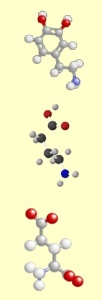 dopamine, adrenalin, glutamate, and GABA (gamma-aminobutyric acid). [At right, molecular structures of dopamine, GABA, and glutamate.]
dopamine, adrenalin, glutamate, and GABA (gamma-aminobutyric acid). [At right, molecular structures of dopamine, GABA, and glutamate.]
- Dopamine, as mentioned, is a feel-good chemical associated with pleasure and reward. When you see lip-licking and chewing, you’re seeing common manifestations of dopamine release.
- Adrenalin (epinephrine) is produced in the kidneys but impacts brain activity associated with the amygdalae and the Fight or Flight responses.
- Glutamate is an excitatory neurochemical. It gets brain cells fired up and facilitates learning and the formation of memories. But too much stimulation can be bad. Too much glutamate is, in fact, toxic to the brain.
- When glutamate breaks down metabolically it produces GABA (gamma-aminobutyric acid), an inhibitory transmitter. GABA reduces the activity of neurons to which it binds. For us humans, meditation and yoga increase the level of GABA in the brain. Drugs like Valium and Xanax facilitate GABA activity, thereby reducing fear and anxiety.
With just these four common neurochemicals in play, let’s consider some potential learning moments for horse and rider:
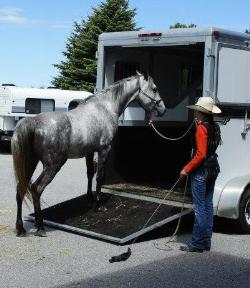 Loading onto a trailer. Crossing a creek:
Loading onto a trailer. Crossing a creek:
Depending on the horse’s behavior as well as your actions and reactions, any number of scenarios could unfold. There may be fear, fight, seeking, reward, flight, or bits of several of these elements.
The scenes are not two-dimensional. Your horse is not wired like a light switch; nor are all horses wired identically. They have different metabolic thresholds, learning frameworks, and memories.
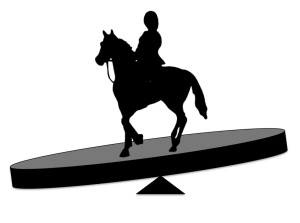 Picture instead your horse on a wobble board:
Picture instead your horse on a wobble board:
- He’s alert and engaged in this potential learning environment.
- Depending on the variables and how you work, he may tip towards pleasure and reward, fall towards fear and panic, or wobble to any number of outcomes between the two extremes.
Read why it’s good to get on the wobble board.
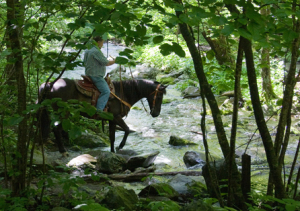 In these and most learning scenarios, horses rely heavily on their brain’s limbic system. That’s the center for emotions and memory related to survival and preservation. Within this region, the amygdala is instrumental in a horse’s fear reaction, which may often present itself in learning situations. The two almond-shaped amygdalae facilitate release of adrenalin and a sympathetic (fight or flight) response may occur.
In these and most learning scenarios, horses rely heavily on their brain’s limbic system. That’s the center for emotions and memory related to survival and preservation. Within this region, the amygdala is instrumental in a horse’s fear reaction, which may often present itself in learning situations. The two almond-shaped amygdalae facilitate release of adrenalin and a sympathetic (fight or flight) response may occur.
But there is another crucial limbic system part called the nucleus accumbens. (Again, the limbic system involves feeling and reacting but not so much thinking.)
This group of neurons is associated with seeking and reward; the area is awash in dopamine.
For the horse, dopamine is the treat. Successful trailer loads and creek crossings mean letting the horse seek a solution and be rewarded. At first, it could be a few steps in the right direction, rewarded with a pause and a rub of affection. For the more hesitant 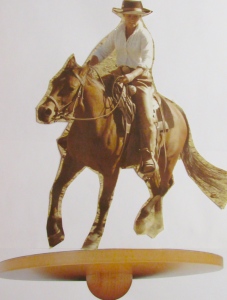 horse, it could be a tiny lean in the right direction. Soon, the horse will discover your intentions and look to do the right thing to get that reward.
horse, it could be a tiny lean in the right direction. Soon, the horse will discover your intentions and look to do the right thing to get that reward.
Temple Grandin calls these seeking moments full of “Christmas present” emotion. “The anticipation of what you’re going to get is sometimes better than actually getting it.” Interestingly, researchers have pinpointed the nucleus accumbens as essential in the placebo effect. The greater the anticipation of pain relief, the greater the nucleus accumbens’ dopamine release, even when no actual chemical reduced the pain.
As you work with your horses, know that the key to positive outcomes is allowing your horse to seek a solution and be motivated by the reward (dopamine). Try to make every learning experience a positive one, since undoing bad experiences can be so challenging.
Sure, you can force him into the trailer and across the creek, but you’ve just tipped off the wobble board into fear territory. What has he learned? How will he consider things next time?
You’ve got your ingredients. Make something delicious and healthy.
Check out Horse Head: Brain Science & Other Insights.
Or, visit Horse Head, our brain science blog.
Nice job of articulating the complex neuochemistry of the horse brain and the wobble board is a great working model to visualize the constantly changing mixture of neurochemicals during learning and how to recognize and optimize the best avenue for your hose to progress/learn/grow.
I’ve been there on that wobble board where my horse seems to be trying to sort out about a dozen different emotions. Too much and he will bolt, too little and he freezes, just enough and he can move ahead.
This will help me to hang with him and help him find that place to move forward. I’ve just never heard it put like this. Makes sense.
Great article. It’s sometimes hard to consider the horse’s perspective when we are so focused on the task but this does reinforce and remind us how critical that is. I have especially noticed this with starting a horse. If they have a good experience, that continues long term even if there are blips along the way, but if was a bad experience sometimes that gets in the way throughout the rest of their experiences with humans.
The wobble board is a great analogy to help the human understand the horse’s learning process. The challenge for the human is to listen to the horse and recognize those small tries. Recognizing and rewarding those small tries maintains a positive balance. As we get greedy and push harder, the human can easily push a horse to fear and self preservation.
This was so clear cut and interesting. I love Temple Grandin and her approach is so clear and concise. Thank you for sharng this, it produces a great approach to looking at things. As always, I LOVE NickerNew! Thank you for all the efforts to bring such interesting information to our fingertips.
Thanks, Kim!
What terrific advice!
Love all the great horse info!
When you talk about reward, does an actually treat fit in there? Will they have the same dopamine response with a treat as with a release? Does serotonin play a part?
Thx.
Sarah
We consider the release of pressure the reward. That’s the gist of negative reinforcement. For an article on serotonin, check this out https://horsehead.info/serotonin/